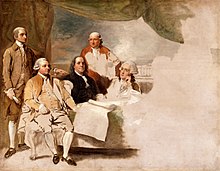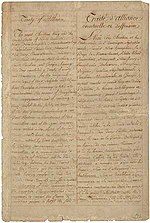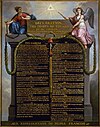Franco-American alliance
| Foreign alliances of France | |||||||||||||||||||||||||||||||||||||||||||||||||||||||||||
|---|---|---|---|---|---|---|---|---|---|---|---|---|---|---|---|---|---|---|---|---|---|---|---|---|---|---|---|---|---|---|---|---|---|---|---|---|---|---|---|---|---|---|---|---|---|---|---|---|---|---|---|---|---|---|---|---|---|---|---|
| |||||||||||||||||||||||||||||||||||||||||||||||||||||||||||
The Franco-American alliance was the 1778
Background
France had been left deeply alarmed by the
In September 1775, the



The alliance was promoted in the United States by Thomas Jefferson, a Francophile.[3] Based on the Model Treaty of 1776, Jefferson encouraged the role of France as an economic and military partner to the United States to weaken British influence.[4]
In 1776,
I was this morning favored with yours containing the pleasing accounts of the late arrivals at Portsmouth and Boston. That of the French ships of war, with artillery and other military stores, is most valuable. It is my intent to have all the arms that were not immediately wanted by the Eastern States, to be removed to Springfield, as a much safer place than Portsmouth.... I shall also write Congress and press the immediate removal of the artillery, and other military stores from Portsmouth. I would also have you forward the twenty-five chests of arms lately arrived from Martinico to Springfield.
— George Washington letter to General Heath, 2 May 1777.[5]
On 13 June 1777, Gilbert du Motier, Marquis de Lafayette, reached America and joined Washington in the Continental Army as a major general. He participated to the Battle of Brandywine, where he was wounded, and he later served at the Battle of Rhode Island. Lafayette would later return to France during the war to advocate more support for the American cause.
Treaty of Alliance
The alliance was formally negotiated by
Operations

The combined strength of the Americans and the French virtually guaranteed victory against Great Britain.
European front
Naval conflict started in European waters with the First Battle of Ushant in July 1778, and continued with the attempted invasion of Britain by the Armada of 1779.
1st American Campaign
In the summer of 1778, French Admiral
On 6 July 1779, he successfully fought the
2nd American Campaign
In 1780, Rochambeau arrived with a fleet and 6,000 French troops to join the
The
France continued to fight against the British in the 1782
Campaign in India
France further supported the war effort against Great Britain by attacking
Between February 1782 until June 1783, Suffren fought the English admiral
Aftermath

Finally, the Treaty of Paris was signed on 3 September 1783, establishing British recognition of American independence and ending the hostilities.
The 1778 Treaty of Alliance, promising the defense of French territory in the American continent, failed to be observed by the United States as soon as 1793, when France entered in conflict with Great Britain in the Caribbean. All the U.S. could do was to maintain neutrality, but this neutrality was so negative as to forbid the French the right to equip and arm privateers in American ports, or the right to dispose of French prizes in the United States. These reluctances in effect marked the end of the alliance.[7]

As the United States entered into a treaty of commerce with Great Britain in 1794, France started to raid American shipping, seizing 316 ships in 1796.[14] In 1796, the disillusioned Minister Pierre Adet explained: "Jefferson (...) is American, and as such, he cannot sincerely be our friend. An American is the born enemy of all the European peoples", and in 1798, the XYZ Affair considerably worsened Franco-American relations.[15][16]
The events led to the
Britain would also attempt to interfere with American trade and shipping, starting with the
Historical perspectives
This section needs additional citations for verification. (July 2013) |
Many historians originally agreed that the American victory over the British at Saratoga, New York, was the deciding factor in the formation of the alliance. However, in recent decades, historians have begun to rethink the victory's contribution to the formation of the alliance and to see the alliance as an inevitable result of individual governmental interests.
In the wake of the Seven Years' War, the American Revolution began across the Atlantic. Britain's victory against France and its allies in the war made the French feel vulnerable to British power. The French saw the American Revolution as a way to strengthen itself and cripple the British Empire. At the beginning, the French helped fuel the American war effort but did not come out as an official ally on the side of the Americans. American envoys to France, namely Silas Deane, feared so much that the French would never join the war that they thought of telling the French that unless they sufficiently supported the war effort, the Americans would begin peace talks with Britain.
Charles Gravier, comte de Vergennes, appeared ready to offer official treaty negotiations if the Americans promised to remain independent. Because they had consistently maintained that independence was non-negotiable, Vergennes's demand proved that their strategy to threaten reunion with Britain influenced France's thinking. It also demonstrates that the victory at Saratoga played little role in the calculations of American, French, and British diplomats. Indeed, two more months of diplomacy would pass before the signing of the Franco-American treaty.[18]
Bibliography
- Bemis, Samuel Flagg. The Diplomacy of the American Revolution (1935) online edition
- Brands, H. W. The First American: The Life and Times of Benjamin Franklin (2002) excerpt and text search
- Brecher, Frank W. Securing American Independence: John Jay and the French Alliance. Praeger Publishers, 2003. pp. xiv, 327 online
- Chartrand, René, and Back, Francis. The French Army in the American War of Independence Osprey; 1991.
- Corwin, Edward S. French Policy and the American Alliance of 1778 Archon Books; 1962.
- Dull, Jonathan R. (1975) The French Navy and American Independence: A Study of Arms and Diplomacy, 1774–1787. Princeton: Princeton University Press. ISBN 0691069204.
- Dull, Jonathan R. (1985) A Diplomatic History of the American Revolution. New Haven: Yale University Press. ISBN 0300034199.
- Kaplan, Lawrence S. "The Diplomacy of the American Revolution: the Perspective from France." Reviews in American History 1976 4(3): 385–390. ISSN 0048-7511Fulltext in Jstor; review of Dull (1975)
- Ferling, John. "John Adams: Diplomat," William and Mary Quarterly 51 (1994): 227–52.
- Hutson, James H. John Adams and the Diplomacy of the American Revolution (1980).
- Hoffman, Ronald, and Peter J. Albert, eds. Diplomacy and Revolution: The Franco-American Alliance of 1778 (1981)
- Hoffman, Ronald, and Peter J. Albert, eds. Peace and the Peacemakers:The Treaty of Paris of 1783 (1986).
- Hudson, Ruth Strong. The Minister from France: Conrad-Alexandre Gérard, 1729–1790. Lutz, 1994. 279 pp.
- Kaplan, Lawrence S., ed. The American Revolution and "A Candid World (1977)
- Kaplan, Lawrence S. (1987). Entangling Alliances with None: American Foreign Policy in the Age of Jefferson. Kent State University Press. p. 24. ISBN 9780873383479.
- Ketchum, Richard M. Saratoga: Turning Point of America's Revolutionary War. New York: Holt Paperbacks, 1999.
- Kennett, Lee. The French Forces in America, 1780–1783. Greenwood, 1977. 188 pp.
- Lint, Gregg L. "John Adams on the Drafting of the Treaty Plan of 1776," Diplomatic History 2 (1978): 313–20.
- Perkins, James Breck. France in the American Revolution (1911) full text online
- Pritchard, James. "French Strategy and the American Revolution: a Reappraisal." Naval War College Review 1994 47(4): 83–108. ISSN 0028-1484
- Schiff, Stacy. A Great Improvisation: Franklin, France, and the Birth of America (2005)
- Simms, Brendan. Three Victories and a Defeat: The Rise and Fall of the First British Empire. Penguin Books, 2008.
- Stinchcombe, William E. The American Revolution and the French Alliance (1969)
- Tudda, Chris. "A Messiah that Will Never Come." Diplomatic History, issue 5 (November, 2008): pp. 779–810.
- Unger, Harlow Giles. Lafayette (2002) online
See also
- Foreign alliances of France
- France in the American Revolutionary War
- France in the Seven Years War
- Franco-Indian alliance
- French weapons in the American Civil War
- List of French units in the American Revolutionary War
- France–United States relations
French commanders in the alliance
-
La Pérouse
-
Guichen
-
Estaing
-
Suffren
References
- ^ Simms pp. 600–2
- ^ Simms pp. 605–6
- ^ Kaplan (1987), p. 24
- ^ Kaplan (1987), p. 27
- ^ a b Springfield, Mailing Address: Springfield Armory National Historic Site One Armory Square Suite 2; Us, MA 01105 Phone:734-8551 Contact. "Mid-18thC French 4-pounder field gun - Springfield Armory National Historic Site (U.S. National Park Service)". www.nps.gov.
{{cite web}}: CS1 maint: numeric names: authors list (link) - ^ a b Encyclopedia of Tariffs and Trade in U.S. History: The encyclopedia by Cynthia Clark Northrup p. 149 [1]
- ^ a b Kaplan (1987), pp. 27-28
- ^ Encyclopedia of Tariffs and Trade in U.S. History: The encyclopedia by Cynthia Clark Northrup p. 150 [2]
- ISBN 9780870816383– via Google Books.
- ^ The American Revolution in Indian country by Colin G. Calloway p. 41 [3]
- ^ "The History Project, University of California". Archived from the original on 2011-09-29. Retrieved 2009-06-14.
- ^ ISBN 9780203007617– via Google Books.
- ^ Cambridge Illustrated Atlas of Warfare, p. 159
- ^ a b c Randier, p. 217
- ^ Kaplan (1987), p. 29
- ^ Full Adet quote on Jefferson in Thomas Jefferson by Richard B. Bernstein p. 140 [4]
- ^ Caffery, pp. 56–58
- ^ Tudda, p. 802
Further reading
- Stockley, Andrew (2001). Britain and France at the Birth of America: The European Powers and the Peace Negotiations of 1782–1783. Exeter: University of Exeter Press. ISBN 0859896153.















